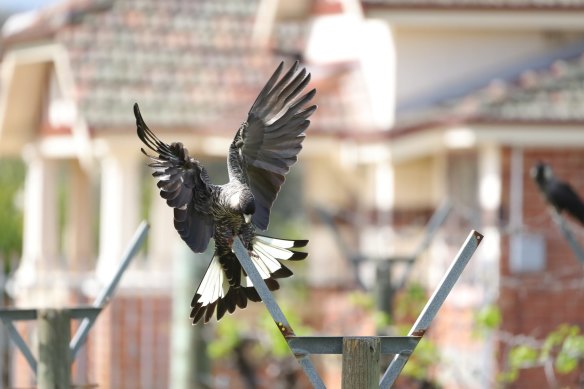
He said one of the major breeding sites north of the Swan Coastal Plain, near Cervantes, was visited three weeks ago and of the nearly 200 artificial and natural hollows, only 11 breeding pairs were recorded as opposed to last year’s more than 100.
“That’s all traced back to food availability,” he said.

Black cockatoos photographed foraging in Caversham recently. Credit: Domenic Di Marco
“There is no action from [Environment Minister] Reece Whitby or any comment; these birds are starving to death in Perth’s urban landscape.
“There needs to be a conversation about short-term survival.”
He said supplementary feeding should be looked at across the Swan Coastal Plain in contravention of government policy.
“If they don’t do that these birds will starve. And [the department] is doing nothing,” he said.
Prominent Perth botanist Professor Kingsley Dixon said the Carnaby’s black cockatoo had evolved for four million years eating the banksia woodlands of the Swan Coastal Plain.
He said what Perth was now witnessing with the drying climate was “a catastrophic failure of the banskias to be setting seed, leading to the mass starvation of the bird.”
He said the banksias’ poor and irregular flowing and very low seed set was attributable to two key factors: climate change and the largest remaining areas experiencing large prescription scrub burning, scuppering reproductive efforts.
He said this fragmentation and inappropriate management compounded by climate change had led to this extraordinary and unprecedented situation.
Loading
“This reproductive failure has never before been seen … they are just shutting down,” he said.
“The Carnaby’s are now refugees in their own country.”
Dixon said 2 million banksias must be planted as soon as possible and meanwhile the government should set up an urgent multidisciplinary taskforce.
Environment Minister Reece Whitby said he had asked the Department of Biodiversity, Conservation and Attractions to examine these issues and report back to him at the soonest opportunity.
Meanwhile, he said, the Cook Labor government would always do what was right for the environment.
It had undertaken the state’s largest-ever conservation drive through its Plan for Our Parks, ended native forest logging and retained 1800 hectares of pine forest in Perth’s north-east for black cockatoos.
He said the government stood by the value and importance of prescribed burning and the department’s research in this area.
A DBCA spokesperson confirmed there had been an increase in underweight cockatoos brought to the Zoo, and the start to the breeding season was delayed, all likely due to the climatic conditions affecting food sources.
They said while the department had collaborated with Murdoch University scientists to better understand vegetation die-off, it did not consider setting up feeding stations feasible due to the extensive range of their breeding habitat.
They said they would continue to examine these issues as the breeding season continued and consider any action that might be feasible.
What you can do
DBCA says the immediate priority is to support black cockatoos already affected. Report sick or injured cockatoos to the Wildcare Helpline on 9474 9055, Kaarakin on 9390 2288 or Native Animal Rescue on 9249 3434.
Note: providing food to wild animals requires careful consideration to ensure it can provide greater benefits than risks (of disease, increased predation and aggression between wild animals, appropriate locations and food types, and avoiding increases in pest and feral animals being attracted to the feed sites.)
Start the day with a summary of the day’s most important and interesting stories, analysis and insights. Sign up for our Morning Edition newsletter.









 Add Category
Add Category